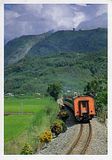
 Built as a strategic military route, The Transfăgărăşan (trans + Făgăraş) or DN7C is the highest and most dramatic paved road in Romania. It runs North to South across the tallest sections of the Carpathian Mountains, between the highest peak in the country, Moldoveanu, and the second highest, Negoiu. The road connects the historic regions of Transylvania and Wallachia, and the cities of Sibiu and Piteşti.
Built as a strategic military route, The Transfăgărăşan (trans + Făgăraş) or DN7C is the highest and most dramatic paved road in Romania. It runs North to South across the tallest sections of the Carpathian Mountains, between the highest peak in the country, Moldoveanu, and the second highest, Negoiu. The road connects the historic regions of Transylvania and Wallachia, and the cities of Sibiu and Piteşti.The road climbs to 2.034 meters altitude. The most spectacular route is from the North. It is a winding road, dotted with steep hairpin turns, long S-curves, and sharp descents. The Transfagarasan is both an attraction and a challenge for hikers, cyclists, drivers and motorcycle enthusiasts alike. Due to the topography, the average speed is around 40 km/h. The road also provides access to Bâlea Lake and Bâlea Waterfall.
The road is usually closed from late October until late June because of snow. Depending on the weather, it may remain open until as late as November. It may also be closed, at times, because of weather conditions (it occasionally snows even in August). There is a sign at the town of Curtea de Argeş that provides information on the passage. Travelers can find food and lodging at several hotels or chalets (cabane) along the way.
It has more tunnels (a total of 5) and viaducts than any other road in Romania; in the vicinity of the highest point, at Bâlea Lake, the road passes through the longest road tunnel in Romania (884 m).
Among the attractions along the southern section of the road, near the village of Arefu, is the Poienari fortress. The castle served as the residence of Vlad III the Impaler, the king who inspired Bram Stoker’s Dracula character. There is a parking area and a path to the ruins.
The northern section is used as a part of yearly cyclist competitions Tour of Romania (Romanian: Turul României). The difficulty of this section is considered to be very similar to Hors Categorie climb (literally beyond categorization) in Tour de France.































No comments:
Post a Comment